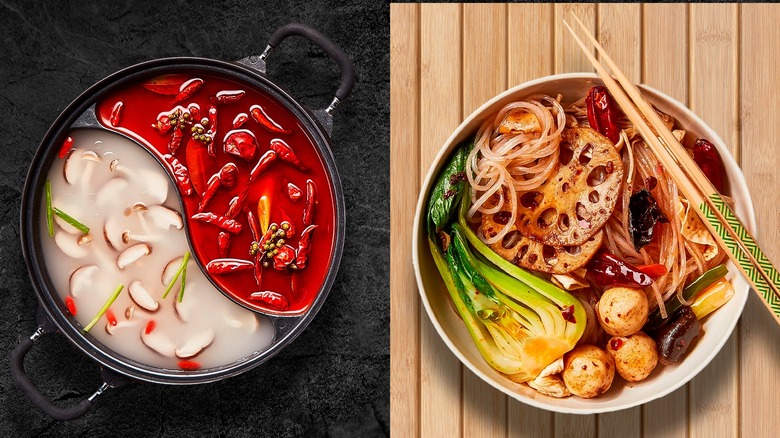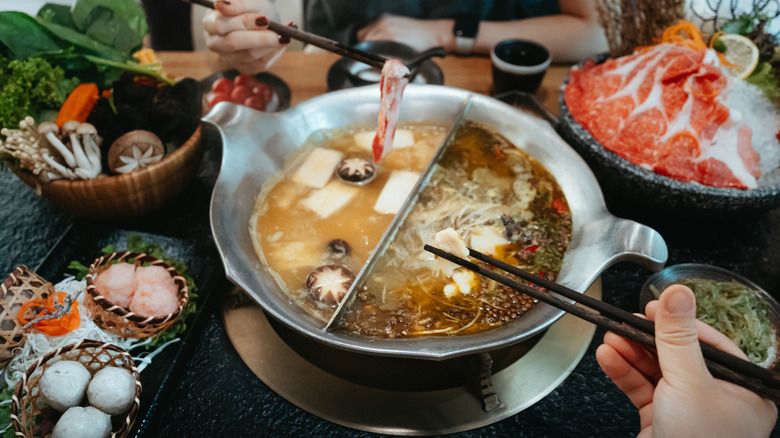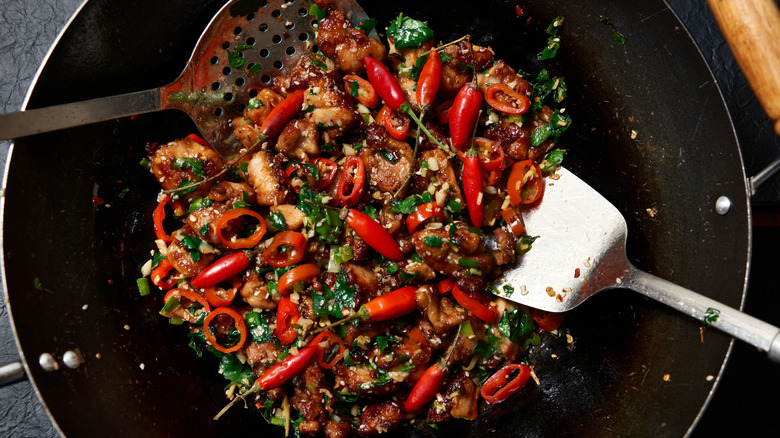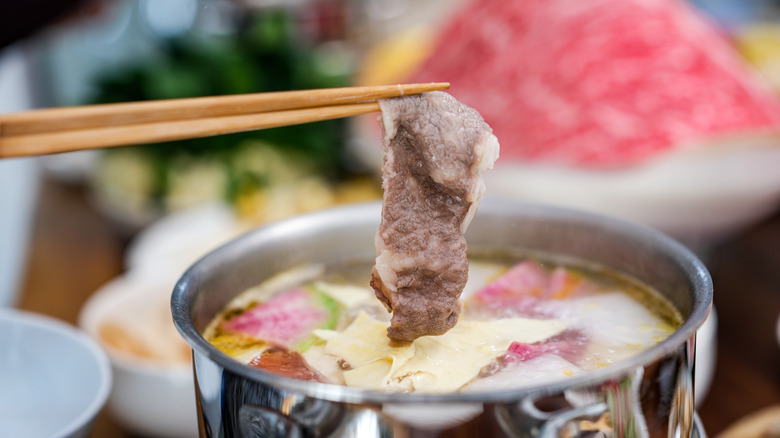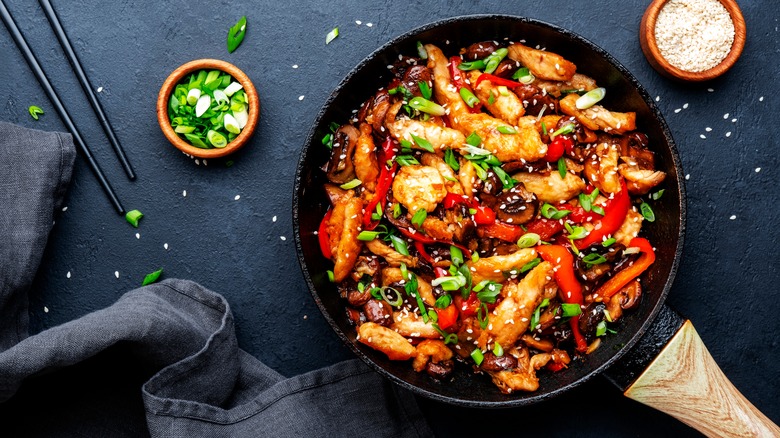Hot Pot Vs Dry Pot: What's The Difference Between The Two?
We may receive a commission on purchases made from links.
Don't get it twisted, dry pot isn't dry at all. It's actually coated in a thick, silky sauce, bursting with robust flavor and lots of moisture. Ostensibly, the dish's arid name comes from an unspoken comparison to its culinary cousin, another Chinese classic: hot pot.
These two adjacently-named dishes marry sweet, sour, spicy, savory, and umami flavors into a single cohesive meal packed with nutrients and protein. Both hot pot and dry pot contain a similar kaleidoscope of different ingredients: meat, seafood, and tofu, vegetables like wood ear, oyster, and enoki mushrooms, bamboo shoots, cauliflower, daikon radish, lotus root, napa cabbage, bok choy, ginger, and garlic, plus starches like rice cakes and noodles. So what makes hot pot different from dry pot (especially if dry pot isn't even all that dry)?
The primary difference between these dishes is that hot pot resembles a deconstructed soup, with bite-sized pieces of raw food being cooked to-order tableside in a boiling pot of broth, while dry pot is more similar to a classic stir-fry, with no tableside cooking or broth to be found.
What is hot pot?
In traditional Chinese hot pot (aka huo guo), the table setting consists of a large metal pot placed over a heating element like an electric burner or portable gas stove, and the broth inside is heated until boiling. Around the central bubbling cauldron is a spread of raw ingredients which have been cut into bite-sized pieces for quick cooking. These chunks of tofu, veggie florets, whole dumplings, and thin strips of beef or other meats get submerged in the boiling liquid to cook, typically between 30 seconds to a full minute. Each bite is cooked individually, held using chopsticks or specialized ladle-like wire hot pot baskets. The tableside cooking is a fun, social way to enjoy a meal, plus it majorly cuts down on prep time for the host. Guests can also dip their cooked bites in whatever dipping sauces they choose to customize the flavor. Peanut sauce, soy sauce, chili oil, and fish sauce are common.
Hot pot bears historical ties to the Mongolian Empire of East Asia, and has been enjoyed in some form for thousands of years. Per the lore, members of the Mongol army of yore used to prepare the dish right in their metal helmets, and as the army traveled, the dish spread to Korea, Japan, and Vietnam, all of which have adopted their own versions of Chinese hot pot. Nowadays, take a trip to NYC, and you'll find no shortage of modern hot pot restaurants thriving in the five boroughs.
What is dry pot?
With dry pot (aka Gān Guō), it's all about the interplay of different textures and flavors. The veggies and protein are stir-fried and slathered in a rich, bold sauce, and typically scooped over a mound of white rice to serve. Dry pot sauces are lusciously thick, highly fragrant, and typically always on the spicy side, predominantly featuring fermented soybeans and tingly Sichuan numbing spices. In fact, dry pot is often paired with an alcoholic beverage to help temper the spicy heat, like Tsing Tao beer or chilled sake. Still, dry pot is more about flavorful balanced spiciness than inaccessibly intense heat.
To make dry pot, the vegetables get prepared with a simple blanche, the protein is pan-seared, any aromatics get sauteed, and the blanched veggies and cooked meat get coated in thick sauce, stirring to combine. Popular dry pot proteins include tofu, beef tripe, tongue, pork liver, short ribs, grilled chicken, or Spam, which can also be pre-marinated for richer flavor. Less predictable ingredients like broccolini or even russet potatoes can also be added into the mix.
Per the lore, dry pot didn't start cropping up in the food scene until the 1970s in the Chongqing municipality of Southwestern China. Chongqing city belonged to the Sichuan province until 1997, which might be partially responsible for the heavy Sichuan culinary influence on dry pot's ingredients. Still, this history is debated. Other sources credit dry pot's origin to China's Chengdu province.
Hot pot is all about the broth, and eating it is a sit-down event
With hot pot, it's all about the bubbling cauldron of hot broth, whereas in dry pot — as the name might suggest — there's no broth to be found at all. As the star of the show, hot pot broth (guo di) can feature a variety of different flavors. Hot pot is a staple in China, where many different regions showcase specific ingredients, like the flavorful numbing-spiced broth of Chongqing sichuan hot pot, wild mushroom Yunnan hot pot, and Mongolian lamb hot pot.
In China's northern provinces, Beijing-style Qing Tang guo di clear broth is the most popular hot pot option, made from a mild combination of water and aromatics like scallions, ginger, peppers, shiitake mushrooms, and goji berries. Pre-made store-bought hot pot base can also be purchased from most Asian specialty groceries or from a variety of online retailers; Lee Kum Kee brand is popular on Amazon.
The functional aspect of hot pot's boiling broth also does not extend to the brothless dry pot. Whereas in hot pot, thin slices of raw beef and raw shrimp can be cooked directly in the broth, in dry pot, physically larger proteins, like a full chicken breast or chunked short rib, might need to be cooked separately, then added to the stir-fry pan to incorporate with the sauce and veggies retroactively.
Dry pot is more of a stir-fry and is assembled in the kitchen rather than at the table
Where hot pot more closely resembles a soup, dry pot is closer to a stir fry. Subsequently, hot pot also tends to be soft and tender while dry pot features more textural variety. Dry pot often includes chewy rice cakes or glass noodles as well as sliced bell peppers or bean sprouts for crunch. The dish is relatively quick to prepare and it all comes together in one pan, serving as a great make-ahead lunch — none of which can be said of hot pot.
Another key difference between hot pot and dry pot is the communal aspect. Hot pot revolves around a central cauldron of broth, encouraging foodies to get involved in cooking their own meals as part of an experiential dining event. When enjoying hot pot, it's as much about eating the actual meal as it is about the shared process of cooking together tableside and experimenting with different customized bites. It's especially popular during the chillier weather of autumn and winter. Dry pot, by contrast, more closely follows the standard mealtime outline of a finished, prepared food from a large serving bowl onto a personal smaller dish — all of the cooking is completed by the time the dry pot hits the table.
